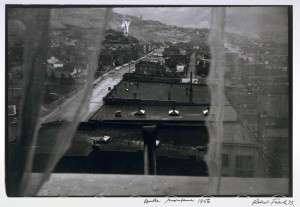Under the Boot-Soles, No. 2
This is the second instalment in a series of posts meant to dig Whitman out the places people put him in, overtly or otherwise. (I count Chelsea’s Ginsberg entry as the first.) Since Whitman so lustily “bequeaths” himself to the world, hoping that every reader will exceed his work (and thereby add grandeur to it), can we see the proliferation of Whitmanisms and Whitman references as a practical fulfilment of his creative and professional hopes? I find it fitting that Whitman’s insistence on readers using his poetry as a template for their own self-filtering would prompt new writers and other artists to converse with him in their own work.
For today:
This week’s issue of The New Yorker includes an article by Anthony Lane discussing Robert Frank, the photographer whose 1958 collection titled “The Americans” garnered no small measure of notoriety on its publication in the US in 1960. Many American viewers took Frank as, in Lane’s words, “a hater and an agitator, the enemy within,” largely because of Frank’s attempt to document the broadest swathe of American life possible, levelling his eye and not excluding the unsavory. Lane turns to Whitman to make sense of this:
“In short, ‘The Americans’ was un-American. What nerves were being hit by the ‘Swiss Mister,’ as Photo Arts labelled Frank when it printed some of his work? [Frank moved to America from his native Switzerland in 1947, at about age 23.] A full answer would have to reach back at least a hundred years–to the first edition of Leaves of Grass, and its clarion call of exhilaration. Whitman, like Frank, unrolled a litany of the visages and everyday deeds that would rise up and meet the traveller. .. When Frank set off, however, exactly a century after Whitman’s ‘ psalm of the republic,’ he stumbled into solitudes. From them he forged what Evans called the ‘ungentle poetry’ of ‘The Americans'” (89).
This particular Whitman invocation also broaches the crucial question of the extent to which America has, or even had in Frank’s 1955 version, realized the vision that Whitman affirms is manifestly inevitable.
Anyway, please add to the succession of posts that Chelsea began and I hope to continue! Finding Whitman takes little more than a realization that we should be looking.

Frank's photo of Butte, Montana: America's 'ungentle poetry'
September 10th, 2009 at 4:04 pm
Sam– I just read that same article on this photographer, & I bet he’d be gratified to know you brought him up alongside Whitman. Lane writes, “No wonder that Frank so despised the heartening photographic layouts in Life [magazine]–‘those god-damned stories with a beginning and an end.'” Whitman doesn’t mind beginnings, but he definitely rejects pat endings.